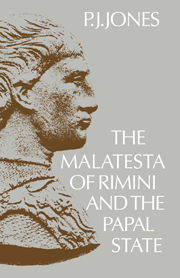Book contents
- Frontmatter
- Contents
- Dedication
- Preface
- Abbreviations
- Map of Romagna and the Marche in the later Middle Ages
- 1 The Papal State and Romagna in the thirteenth century
- 2 Rimini and the rise of the Malatesta
- 3 From commune to papal vicariate
- 4 Galeotto Malatesta, ‘ecclesie pugil’
- 5 The prime of Malatesta rule: Carlo Malatesta
- 6 The pontificate of Martin V
- 7 Sigismondo Pandolfo Malatesta, ‘fex Italiae’
- 8 The papal reconquest
- 9 The government of the Malatesta: I. The papal vicariate
- 10 The government of the Malatesta: II. The signoria
- Appendix
- Bibliography
- Index
10 - The government of the Malatesta: II. The signoria
Published online by Cambridge University Press: 23 December 2009
- Frontmatter
- Contents
- Dedication
- Preface
- Abbreviations
- Map of Romagna and the Marche in the later Middle Ages
- 1 The Papal State and Romagna in the thirteenth century
- 2 Rimini and the rise of the Malatesta
- 3 From commune to papal vicariate
- 4 Galeotto Malatesta, ‘ecclesie pugil’
- 5 The prime of Malatesta rule: Carlo Malatesta
- 6 The pontificate of Martin V
- 7 Sigismondo Pandolfo Malatesta, ‘fex Italiae’
- 8 The papal reconquest
- 9 The government of the Malatesta: I. The papal vicariate
- 10 The government of the Malatesta: II. The signoria
- Appendix
- Bibliography
- Index
Summary
It was inevitable that the papacy when seeking to evict the Malatesta should describe them as subjects, disobedient subjects, of the church, for such in law they were. But in the political life of Italy they were much more than this, as Pius II quickly found. They were members of a princely dynasty who could raise armies, despatch embassies and conclude alliances independently of their papal sovereign. They could regard themselves as lords in their own right, and were not therefore content, when issuing decrees or publishing laws, merely to adopt the title of vicar. ‘Vicars’ indeed they did on occasion call themselves, but it was not the style that they or their officials made use of most. ‘Rector’ or ‘gubernator’ were equally favoured, and still more ‘dominus’ or ‘signore’, which, in all its vagueness, remained supreme among the titles of the Malatesta, until at the end of the fifteenth century ‘princeps’ began to appear in public documents and inscriptions.
The Malatesta had been domini, both formally and in fact, before ever they gained the papal vicariate, and earlier still they had been landed magnates of prominence. It is as landowners that the Malatesta first appear, and landowners they all remained. Their private estates lay thickly everywhere and lasted as a source of income and influence as long as the signoria. Possessed of property from the earliest times in Rimini and Verucchio, the Malatesta are seen from the middle of the thirteenth century to be acquiring lands indefatigably both there and further afield, in Bellaria, Santarcangelo, Gradara, Savignano, Roncofreddo, Montescudolo, Montefiore, and many other castles and villages.
- Type
- Chapter
- Information
- The Malatesta of Rimini and the Papal State , pp. 289 - 338Publisher: Cambridge University PressPrint publication year: 1974



